-
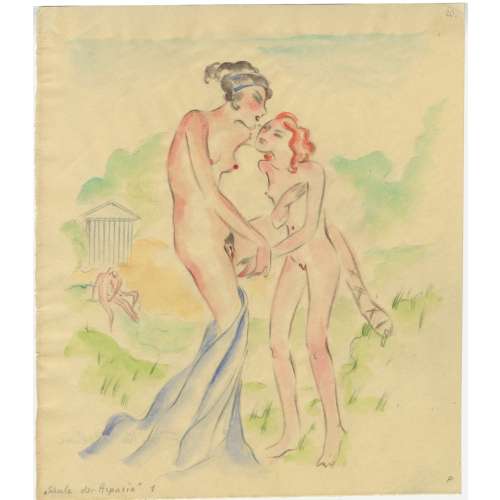 NEWPencil and watercolour on paper 230 x 197 mm, pencil ms inscription in the bottom-left “Schule der Aspasia” 1 (2, 3), monogrammed “P” in the bottom-right, and “Erika Plehn” to verso. Apparently, illustrations for ‘Die Weisheiten der Aspasia’ also known as ‘Die Dirnenschule der Aspasia’ (Aspasia's prostitute school), an erotic novel by Fritz Thurn (Foregger), privately published in Vienna in 1923. Artist: Erika Plehn [née Erika Pinkus] (German, 1904 – 1988) Author: Fritz Thurn [Foregger zum Greiffenthurn] (Austrian, 1877 – 1938). Aspasia of Miletus (Greek, c. 464 BCE – c. 420 BCE)
NEWPencil and watercolour on paper 230 x 197 mm, pencil ms inscription in the bottom-left “Schule der Aspasia” 1 (2, 3), monogrammed “P” in the bottom-right, and “Erika Plehn” to verso. Apparently, illustrations for ‘Die Weisheiten der Aspasia’ also known as ‘Die Dirnenschule der Aspasia’ (Aspasia's prostitute school), an erotic novel by Fritz Thurn (Foregger), privately published in Vienna in 1923. Artist: Erika Plehn [née Erika Pinkus] (German, 1904 – 1988) Author: Fritz Thurn [Foregger zum Greiffenthurn] (Austrian, 1877 – 1938). Aspasia of Miletus (Greek, c. 464 BCE – c. 420 BCE) -
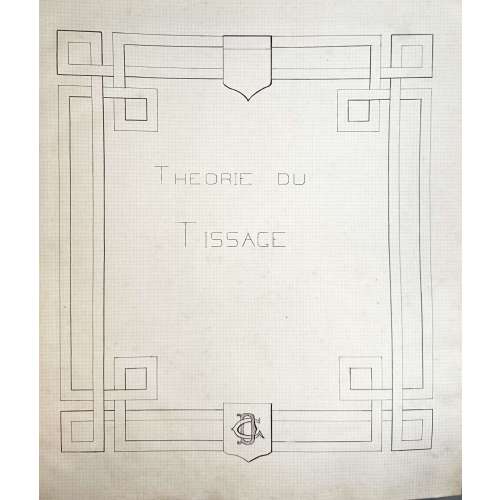 NEWAnonymous manuscript half bound in green sheepskin, gilt lettering to spine, 382 x 325 x 65 mm, 424 pp. with pp. 368-400 blank, thick graph paper, tissue samples pasted throughout. According to the seller: “Important treatise on weaving decorated with numerous drawings, sketches, diagrams and samples of laminated fabrics (satin, silk, damask, velvet, etc.). Elegant work, beautiful writing in italics, all pages in a framing net. It contains chapters on the history of silk, the silkworm (hatching, transformation, etc.), silk spinning, dyeing, warping, folding, heddles, different types of mesh, satin, satin drifts, damask for dresses, royal damask for furnishings, velvet, etc. etc.”
NEWAnonymous manuscript half bound in green sheepskin, gilt lettering to spine, 382 x 325 x 65 mm, 424 pp. with pp. 368-400 blank, thick graph paper, tissue samples pasted throughout. According to the seller: “Important treatise on weaving decorated with numerous drawings, sketches, diagrams and samples of laminated fabrics (satin, silk, damask, velvet, etc.). Elegant work, beautiful writing in italics, all pages in a framing net. It contains chapters on the history of silk, the silkworm (hatching, transformation, etc.), silk spinning, dyeing, warping, folding, heddles, different types of mesh, satin, satin drifts, damask for dresses, royal damask for furnishings, velvet, etc. etc.” -
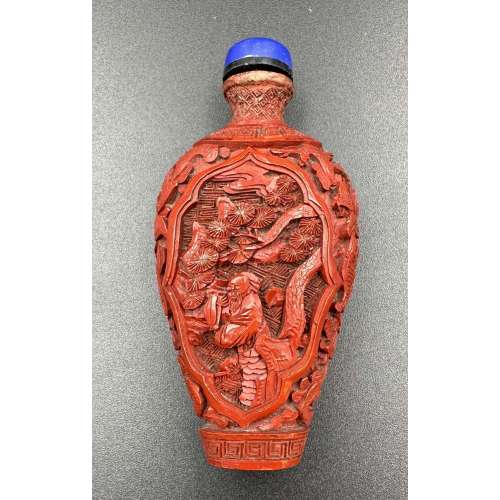 Cinnabar lacquer snuff bottle carved in low relief with a scholar under a pine tree and another under a maple, with lapis lazuli stopper and black collar. Early 20th century Dimansions: H77 x W36 x D19 mm.
Cinnabar lacquer snuff bottle carved in low relief with a scholar under a pine tree and another under a maple, with lapis lazuli stopper and black collar. Early 20th century Dimansions: H77 x W36 x D19 mm. -
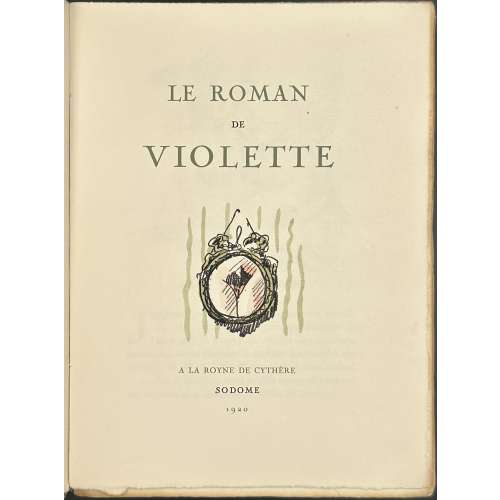 Softcover volume, 19.5 x 14.3 cm, olive French flapped wrappers, glassine dust cover, printed on laid paper (Hollande), outer and bottom margins untrimmed, some pages uncut; pagination: [2] blank, [i-iv] h.t./limit., t.p./blank, v-viii, 1-196 [197] [5], total 212 pages plus frontispiece; head- and tailpieces and in-text stencil-coloured etchings after Chéripoulos. Title-page (olive and black): LE ROMAN | DE | VIOLETTE | {vignette} | A LA ROYNE DE CYTHÈRE | SODOME | 1920 || Limitation: Cet ouvrage, achevé d'imprimer le cinq Janvier Mil Neuf Cent Vingt à trois cents exemplaires dont vingt-cinq exemplaires sur Japon Impérial contenant chacun un dessin original de Chéripoulos, numérotés de un à vingt-cinq; deux cent soixante-quinze exemplaires sur papier de Hollande, numérotés de vingt-six à trois cents; en plus cinq exemplaires de collaborateurs marqués de A à E. Le présent exemplaire porte le numéro 72. Edition: Printed on the 5th of January 1920 in 305 copies (№№ 1-25 on Japon Impérial, №№ 26-300 on Hollande, A–E for collaborators). Catalogue raisonné: Dutel III № 2339, p. 350. Contributors: Henriette de Mannoury d'Ectot [Henriette Nicolas Le Blanc] (French 1815 – 1899) Charles Auguste Edelmann [Chéripoulos] (French, 1879 – 1950).
Softcover volume, 19.5 x 14.3 cm, olive French flapped wrappers, glassine dust cover, printed on laid paper (Hollande), outer and bottom margins untrimmed, some pages uncut; pagination: [2] blank, [i-iv] h.t./limit., t.p./blank, v-viii, 1-196 [197] [5], total 212 pages plus frontispiece; head- and tailpieces and in-text stencil-coloured etchings after Chéripoulos. Title-page (olive and black): LE ROMAN | DE | VIOLETTE | {vignette} | A LA ROYNE DE CYTHÈRE | SODOME | 1920 || Limitation: Cet ouvrage, achevé d'imprimer le cinq Janvier Mil Neuf Cent Vingt à trois cents exemplaires dont vingt-cinq exemplaires sur Japon Impérial contenant chacun un dessin original de Chéripoulos, numérotés de un à vingt-cinq; deux cent soixante-quinze exemplaires sur papier de Hollande, numérotés de vingt-six à trois cents; en plus cinq exemplaires de collaborateurs marqués de A à E. Le présent exemplaire porte le numéro 72. Edition: Printed on the 5th of January 1920 in 305 copies (№№ 1-25 on Japon Impérial, №№ 26-300 on Hollande, A–E for collaborators). Catalogue raisonné: Dutel III № 2339, p. 350. Contributors: Henriette de Mannoury d'Ectot [Henriette Nicolas Le Blanc] (French 1815 – 1899) Charles Auguste Edelmann [Chéripoulos] (French, 1879 – 1950). -
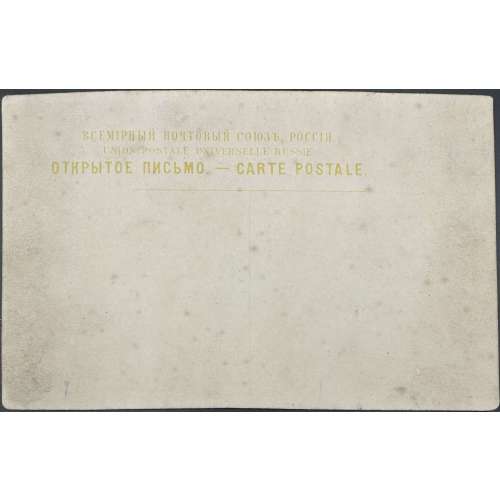 Ten postcards 90 x 140 mm, text in yellow "ВСЕМIРНЫЙ ПОЧТОВЫЙ СОЮЗЪ. РОССIЯ. | UNION POSTALE UNIVERSELLE RUSSIE. | ОТКРЫТОЕ ПИСЬМО. — CARTE POSTALE. || On the reverse, a blue ink woodcut image is printed in the upper left corner, and a blue ink numbered image title is in the bottom centre. Holding the postcard against the backlight reveals a hidden image of an indecent nature (erotic). The use of Latin characters "R" and "N" instead of Russian "Р" and "Н" suggests that the cards were produced in Europe, probably in France. Inscriptions: 1. ПЕRВЫЕ ДNИ; 2. ПОRА ЛЮБВИ; 3. ВЪ ЛЮДИ; 4. КЪ "СВОБОДNОМУ ИСКУССТВУ"; 5. "СВОБОДNЫЙ ТRУДЪ; 6. БЕЗЪ ГОRЯ И ПЕЧАЛИ; 7. NАЗАДЪ КЪ "СВОБОДNОЙ ЛЮБВИ"; 8. ВСЕ ЧТО ОСТАЛОСЬ!; 9. БЕЗЪ КRОВА И ПRИСТАNИЩА; 10. ИЗЪ ЗА ХЛѢБА.
Ten postcards 90 x 140 mm, text in yellow "ВСЕМIРНЫЙ ПОЧТОВЫЙ СОЮЗЪ. РОССIЯ. | UNION POSTALE UNIVERSELLE RUSSIE. | ОТКРЫТОЕ ПИСЬМО. — CARTE POSTALE. || On the reverse, a blue ink woodcut image is printed in the upper left corner, and a blue ink numbered image title is in the bottom centre. Holding the postcard against the backlight reveals a hidden image of an indecent nature (erotic). The use of Latin characters "R" and "N" instead of Russian "Р" and "Н" suggests that the cards were produced in Europe, probably in France. Inscriptions: 1. ПЕRВЫЕ ДNИ; 2. ПОRА ЛЮБВИ; 3. ВЪ ЛЮДИ; 4. КЪ "СВОБОДNОМУ ИСКУССТВУ"; 5. "СВОБОДNЫЙ ТRУДЪ; 6. БЕЗЪ ГОRЯ И ПЕЧАЛИ; 7. NАЗАДЪ КЪ "СВОБОДNОЙ ЛЮБВИ"; 8. ВСЕ ЧТО ОСТАЛОСЬ!; 9. БЕЗЪ КRОВА И ПRИСТАNИЩА; 10. ИЗЪ ЗА ХЛѢБА. -
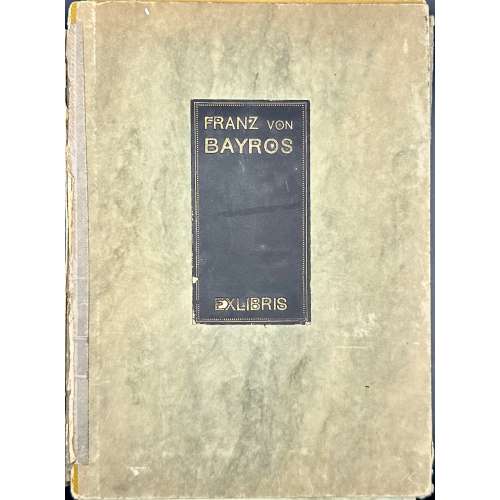 A set of 49 prints, heliogravures and etchings, tipped-in on 285 x 257 mm grey cards, in a green marbled folder with a gilt-lettered black label to the front. No publisher, no place, no year (s.l., s.n., s.d.), printed in circa 1910.
A set of 49 prints, heliogravures and etchings, tipped-in on 285 x 257 mm grey cards, in a green marbled folder with a gilt-lettered black label to the front. No publisher, no place, no year (s.l., s.n., s.d.), printed in circa 1910.- Vlastimil Blažek (Czech, 1878 – 1950): heliogravure, sheet 180 x 137 mm, plate 152 x 114 mm; laid paper, black sepia ink; unsigned.
- Ex libris Gerhard Wunderlich (architect in Dresden): heliogravure, sheet 205 x 150 mm, plate 158 x 115 mm; wove paper, brown sepia ink; inscription: heliogravure, sheet 180 x 137 mm, plate 152 x 114 mm; laid paper, sepia ink; inscription to top “Es ist alles so eng”; signed “F (backwards). Bayros”.
- Ex libris William Lipka: heliogravure, sheet 140 x 125 mm, plate 112 x 98 mm; laid paper, black sepia ink; signature hardly legible.
- Nikolaus Schindler (amateur photographer in Vienna): heliogravure, sheet 142 x 150 mm, plate 110 x 117 mm; laid paper, black sepia ink; unsigned.
- Sussy de Coiquard: heliogravure, sheet 160 x 140 mm, plate 128 x 110 mm; laid paper, black sepia ink; unsigned.
- Illegible, looks like “Vielluer Febréy”: heliogravure, sheet 120 x 109 mm, plate 93 x 85 mm; laid paper, black, sepia ink; signed “F (backwards). Bayros:”.
- Ex libris Erich Liebermann-Rosswiese (Greman-Jewish, 1886 – 1942): heliogravure, sheet 180 x 139 mm, plate 118 x 88 mm; wove paper, black sepia ink; unsigned.
- Ex libris Dr. phil. Rudolf Ludwig: before letters, heliogravure, sheet 150 x 132 mm, plate 120 x 110 mm; laid paper, black sepia ink; unsigned. See [LIB-3258.2023] John Cleland. Die Memoiren der Fanny Hill. — Paphos [i.e. Vienna]: C. W. Stern, 1906.
- Unidentified: before letters, heliogravure, sheet 150 x 115 mm, plate 113 x 88 mm; laid paper, black sepia ink; signed “F. Bayros” in the manuscript. Circumstantial evidence tells that this bookplate belongs to someone A.W.(Artur Wolf). See №22.
- Lulu. Monachia. Gest. v. Ritter Dialekt und Junker Erich: heliogravure, sheet 204 x 152 mm, plate 160 x 118 mm; wove paper, black sepia ink; unsigned. See №20.
- Kellner Jstván: (István): heliogravure, sheet 118 x 100 mm, plate 85 x 70 mm; laid paper, black sepia ink; signed “Franz Bayros” in the script (hardly legible).
- Adyton: heliogravure, sheet 170 x 130 mm, plate 113 x 85 mm; wove paper, black, sepia ink; signed “F (backwards). Bayros”.
- 13.Ex libris George Arthur Buhl (American, 1883 – 1959): heliogravure, sheet 166 x 140 mm, plate 120 x 92 mm; wove paper, black sepia ink; inscription “!I will! | !And I can!”; bust inscribed “T. Carlyle”; signed “F (backwards). Bayros” (hardly legible).
- Ex-Libris Heinrich und Lise Fuhrmann: heliogravure, sheet 165 x 149 mm, plate 120 x 103 mm; wove paper, black sepia ink; signed “F (backward). Bayros”; inscription “So schaff ich am sausenden Webstuhl der Zeit und wirke der Gottheit lebendiges Kleid” (from ‘Faust’ by Goethe).
- Ex libris Gerhard Wunderlich (architect in Dresden): heliogravure, sheet 165 x 137 mm, plate 135 x 105 mm; laid paper, black, sepia ink; signed “F (backwards). Bayros”.
- Ex Libris Walther u. Amelia Fahrenhorst; Walter Fahrenhorst (German, 1871 – 1938): heliogravure, sheet 165 x 140 mm, plate 128 x 95 mm; wove paper, black sepia ink; signed “F. Bayros” in the manuscript. The inscription behind the strings: NITOR (lat. beauty, glamour).
- Ex Libris Margot Lewknecht; heliogravure, sheet 145 x 140 mm, plate 128 x 118 mm; laid paper, black sepia ink; signed “F. Bayros”.
- Ex Libris Walther Heinisch (publisher in Carlsbad); heliogravure, sheet 185 x 145 mm, plate 140 x 110 mm; wove paper, sanguine; male bust with an inscription to the base: “Arnold Boeklin” / Arnold Böcklin (Swiss, 1827 – 1901); inscription: “mit gêru scal man geba infâhan” – a line from Hildebrandslied, the earliest poetic text in German. Unsigned.
- Bookplate with music score GGDBGC; heliogravure, sheet 125 x 135 mm, plate 100 x 110 mm, with monogram «HCJ»; laid paper, brown sepia ink; signed “F. Bayros”.
- Bookplate with inscription: Lulu aus Praga | Gest v. Ritter Dialekt / Monachia / Monachia / und Junker Erich; heliogravure, sheet 182 x 147 mm, plate 160 x 120 mm, image 122 x 105 mm; wove paper, bluish-black sepia ink; unsigned. See №10.
- Bookplate, no inscription; heliogravure, laid paper, sepia ink, sheet 148 x 127 mm, image 84 x 79 mm; signed F. Bayros in the manuscript beneath the image.
- Ex libris Artur Wolf: heliogravure, laid paper, sepia ink, sheet 170 x 150 mm, image 120 x 105 mm; signed F. Bayros in the manuscript to the frame of the image. See №9.
- Ex Libris E. K. Weigl: heliogravure, laid paper, sepia ink, sheet 139 x 121 mm, plate 112 x 97 mm; unsigned; inscription above male portrait: “LEONARDO”.
- Ex libris Dr. A. Bergmann: heliogravure, wove paper, sepia ink; sheet 180 x 140 mm, plate 130 x 105 mm; signed F. Bayros in the manuscript.
- Grete Cäcilie (monogram “PS”): heliogravure, laid paper, sepia ink, sheet 161 x 130 mm, plate 128 x 103 mm, signature illegible.
- Emma Steigleder: heliogravure, laid paper, black ink, sheet 181 x 141 mm, plate 158 x 117 mm, signed F. Bayros in the manuscript. Inscription “Si vis amari, ama! Seneca” [If you want to be loved, love] to the attic of the arch.
- Bruno Fischer: heliogravure, laid paper, sepia ink, sheet 186 x 145 mm, plate 155 x 116 mm, signed “F (backward). Bayros”. Inscription to bottom “Gehl Weck’ ihn nicht auf seien wir froh dass er einmal schläft!”
- Harnasch: heliogravure, wove paper, sepia ink; unsigned; sheet 140 x 132 mm, plate 100 x 85 mm; unsigned.
- Eduard Klampfl: heliogravure, laid paper, sepia ink, sheet 165 x 145 mm, plate 135 x 110 mm, signed “F (backwards). Bayros”; portrait bust of the composer Richard Wagner (German, 1813 –1883).
- Jorge Monsalvatje: heliogravure, wove paper, sepia ink; sheet 189 x 160 mm, plate 150 x 115 mm; signed F. Bayros in the manuscript.
- E. K. W.: wove paper, sepia ink; sheet 150 x 120 mm; signed “Bayros”.
- Unidentified bookplate: wove paper, sepia ink; sheet 150 x 120 mm; signed “F. Bayros 09” in the manuscript.
- Ex-Libris Helene and Emil Lemberger: heliogravure (or soft ground etching), laid paper, sepia ink, sheet 180 x 163 mm, plate 150 x 130 mm, signed “F. Bayros” in the manuscript.
- M. Z.: wove paper, sepia ink; sheet 130 x 170 mm, plate 90 x 120 mm; signed “F (backwards) Bayros”.
- Ex libris Frankl Frigyes Vilmos: heliogravure (or soft ground etching), laid paper, sepia ink, sheet 140 x 148 mm, unsigned. Frigyes Frankl, born in Tejfalu, Szlovákia, died in 1943.
- Ex libris Anton Bürck: heliogravure, wove paper, sepia ink; sheet 170 x 137 mm, plate 123 x 104 mm; unsigned. Anton Burck (German,1881 – 1951) of Palatinate, Bavaria.
- Aus den büchern A. W.: heliogravure, laid paper, sepia ink, sheet 152 x 136 mm, plate 120 x 105 mm, signed “F. Bayros” in the manuscript.
- Ex libris Hans Hickl: heliogravure, laid paper, sepia ink, sheet 150 x 125 mm, plate 115 x 95 mm, signed “Ω”.
- Ex libris Karl Wehle: soft ground etching, laid paper, brown sepia ink, sheet 107 x 90 mm, plate 80 x 65 mm, inscription “Gut!” in the centre; unsigned. Karl Wehle (Austrian, 1901 – 1933)
- Ex libris Dr. Paul Berger: etching, laid paper, black ink, sheet 140 x 115 mm, plate 115 x 85 mm, signed “F (backwards). Bayros”.
- Unidentified bookplate: etching, laid paper, black ink, sheet 145 x 115 mm, plate 85 x 70 mm, unsigned.
- Ex Bibliotheca Erotica Carl Georg von Maassen: soft ground etching, india paper, black ink, sheet 76 x 78 mm, signed “FB”.
- Ex Bibliotheca Erotica Carl Georg von Maassen: soft ground etching, india paper, black ink, sheet 79 x 79 mm, signed “F. von Bayros”.
- Paul Mixa: soft ground etching, laid paper, sanguine ink, sheet 122 x 111 mm, plate 90 x 85 mm, inscription: “Gerne hör’ich wenn du singest und ich horche wenn du schweigest” [I like to hear when you sing and I listen when you are silent].
- Ex libris Drs Q. M. Vyskocil.: etching, laid paper, sanguine ink, sheet 141 x 115 mm, plate 115 x 75 mm, inscription: “MIT REINEN HAENDEN” [with pure hands], signed “F. Bayros” in the manuscript.
- Ex libris Andrée Bearn de Riquer: soft ground etching, laid paper, sanguine ink, sheet 136 x 88 mm, plate 100 x 62 mm, signed “F (backwards). Bayros”. Andrée Béarn [Marguerite Laborde] (French, 1880 – 1973), spouse of Alexandre de Riquer (Catalan, 1856 – 1920).
- Ex musicis Drs Blažek VL: etching, wove paper, sanguine ink, sheet 141 x 116 mm, plate 115 x 90 mm, inscription: “MIT REINEN HAENDEN” [with pure hands], signed “F. Bayros” in the manuscript. See Vlastimil Blažek (Czech, 1878 – 1950) № 1 in this series.
- Ex libris Paul Lindenberg: etching, wove paper, sanguine ink, sheet 130 x 114 mm, plate 95 x 90 mm, image 80 x 72 mm, inscription: “ad pios usus” (for pious uses); signed with monogram “F (backwards). B”.
- Unidentified bookplate: heliogravure, laid paper, sanguine ink, sheet 150 x 131 mm, plate 120 x 100 mm, signed “F. Bayros” in the manuscript.
-
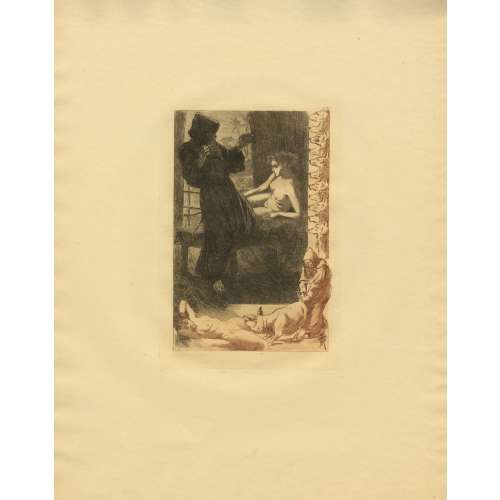 Set of 21 etchings by Martin van Maele for the English edition of ‘Thais’ by Anatole France published in London by Charles Carrington in 1901. Printed on vowe paper without a watermark in two colours with the black image and sepia historiated border. All etchings are inscribed with the artist's monogram; one of the etchings bears inscriptions ORGUEIL, LUXURE, DOUTE (mirror image). Dimensions: sheet: 317 x 250 mm; plate: 170 x 115 mm; image: 155 x 100 mm. Catalogue raisonné: S. A. Perry: № 64. Per Perry, the edition was printed in 500 copies on 'handmade paper watermarked 'Van Gelder'. Contributor: Martin van Maële [Martin, Maurice François Alfred] (French, 1863 – 1926)
Set of 21 etchings by Martin van Maele for the English edition of ‘Thais’ by Anatole France published in London by Charles Carrington in 1901. Printed on vowe paper without a watermark in two colours with the black image and sepia historiated border. All etchings are inscribed with the artist's monogram; one of the etchings bears inscriptions ORGUEIL, LUXURE, DOUTE (mirror image). Dimensions: sheet: 317 x 250 mm; plate: 170 x 115 mm; image: 155 x 100 mm. Catalogue raisonné: S. A. Perry: № 64. Per Perry, the edition was printed in 500 copies on 'handmade paper watermarked 'Van Gelder'. Contributor: Martin van Maële [Martin, Maurice François Alfred] (French, 1863 – 1926) -
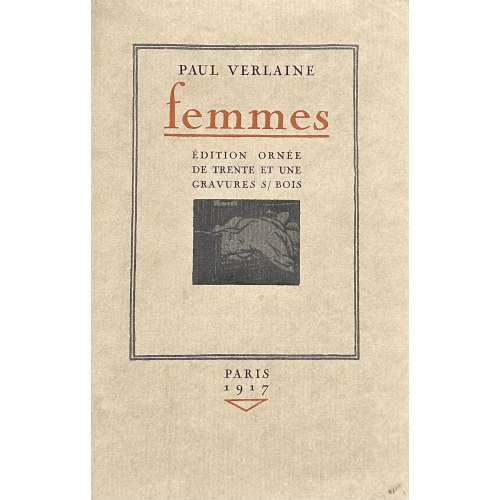 Softcover, 258 x 166 mm, publisher’s olive French flapped wrappers in owner’s glassine dustcover, edges untrimmed, some pages uncut, printed on thick wove paper with watermark “Hollande van Gelder Zonen”, in a slipcase. Pp.: [1-10] 11-129 [5], pages in wrappers included in the count, total 67 leaves; two-tone woodcuts by Jean-Gabriel Daragnès within the pagination. Title-page (red and black, in a double-fillet frame): PAUL VERLAINE | femmes | ÉDITION ORNÉE | DE TRENTE ET UNE | GRAVURES S/ BOIS | {vignette} | (under the bottom frame) PARIS | 1917 | {red triangle} || Limitation: Il a été tiré de cet ouvrage : 11 15 Exemplaires sur vieux papier de Japon numérotés de I à XV; 15 20 Exemplaires sur papier de Chine numérotés de XVI à XXXV; auxquels on a joint une suite des fumés sur même papier. 250 Exemplaires sur papier vélin de Hollande Van Gelder Zonen numérotés de 1 à 250. Après le tirage les bois ont été détruits. № 1. Numbers “15” and “20” corrected manually by Daragnès (per Dutel). This is copy № 1 of vélin de Hollande print run. Catalogue raisonné: Dutel II: № 295; Nordmann II № 544. Seller’s description: Un volume broché in-8° sous couverture illustrée et rempliée. Etui cartonné. Illustré de 31 gravures sur bois en camaïeu, attribuées à DARAGNES, la plupart très libres, dont 18 à pleine page. Tiré à [226 ou 285] ex. numérotés. 1 des [200 ou 250] sur Hollande Van Gelder Zonen. Le nôtre porte le n°1. (Dutel : 295. Pia : 501. Carteret : IV, 392 : Belle édition rare, très estimée ». Monod : 11086). Dorgelès commenta ainsi ces illustrations : « Dans ces nus voluptueux et tragiques, qui semblent à la fois s’aimer et se haïr, on retrouve la même frénésie amère qui tourmente les poèmes interdits de Verlaine » (in Catalogue de livres... Daragnès, Drouot 1924, n°55). Très rares rousseurs. TRES BON EXEMPLAIRE, toujours recherché. Contributors: Paul Verlaine (French, 1844 – 1896) – author. Jean-Gabriel Daragnès (French, 1886 – 1950) – artist/publisher.
Softcover, 258 x 166 mm, publisher’s olive French flapped wrappers in owner’s glassine dustcover, edges untrimmed, some pages uncut, printed on thick wove paper with watermark “Hollande van Gelder Zonen”, in a slipcase. Pp.: [1-10] 11-129 [5], pages in wrappers included in the count, total 67 leaves; two-tone woodcuts by Jean-Gabriel Daragnès within the pagination. Title-page (red and black, in a double-fillet frame): PAUL VERLAINE | femmes | ÉDITION ORNÉE | DE TRENTE ET UNE | GRAVURES S/ BOIS | {vignette} | (under the bottom frame) PARIS | 1917 | {red triangle} || Limitation: Il a été tiré de cet ouvrage : 11 15 Exemplaires sur vieux papier de Japon numérotés de I à XV; 15 20 Exemplaires sur papier de Chine numérotés de XVI à XXXV; auxquels on a joint une suite des fumés sur même papier. 250 Exemplaires sur papier vélin de Hollande Van Gelder Zonen numérotés de 1 à 250. Après le tirage les bois ont été détruits. № 1. Numbers “15” and “20” corrected manually by Daragnès (per Dutel). This is copy № 1 of vélin de Hollande print run. Catalogue raisonné: Dutel II: № 295; Nordmann II № 544. Seller’s description: Un volume broché in-8° sous couverture illustrée et rempliée. Etui cartonné. Illustré de 31 gravures sur bois en camaïeu, attribuées à DARAGNES, la plupart très libres, dont 18 à pleine page. Tiré à [226 ou 285] ex. numérotés. 1 des [200 ou 250] sur Hollande Van Gelder Zonen. Le nôtre porte le n°1. (Dutel : 295. Pia : 501. Carteret : IV, 392 : Belle édition rare, très estimée ». Monod : 11086). Dorgelès commenta ainsi ces illustrations : « Dans ces nus voluptueux et tragiques, qui semblent à la fois s’aimer et se haïr, on retrouve la même frénésie amère qui tourmente les poèmes interdits de Verlaine » (in Catalogue de livres... Daragnès, Drouot 1924, n°55). Très rares rousseurs. TRES BON EXEMPLAIRE, toujours recherché. Contributors: Paul Verlaine (French, 1844 – 1896) – author. Jean-Gabriel Daragnès (French, 1886 – 1950) – artist/publisher. -
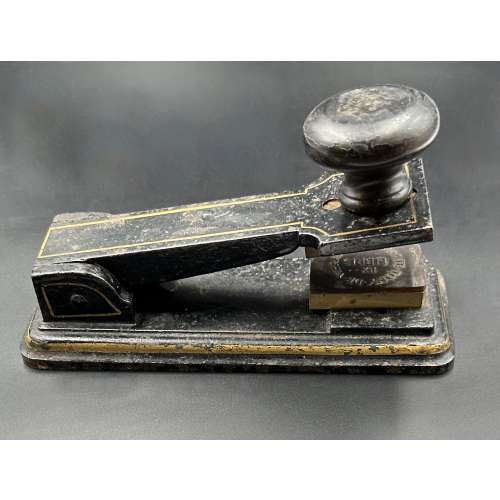 Iron pliers painted black and outlined in gilt lacquer, with wooden handle and bronze seals, "Ex Libris Comte Tony de Vibraye", L17.1 x W6.9 x H7.5 cm. Provenance: Antoine Henri Gaston Hurault de Vibraye [Comte Tony de Vibraye] (French, 1893 – 1951). The book with such a stamp in this library: [LIB-3243.2023] Crébillon fils. La Nuit et le moment ou Les Matinées de Cythère / Illustrations de Sylvain Sauvage. — Paris: Au dépens d’un amateur, 1924.
Iron pliers painted black and outlined in gilt lacquer, with wooden handle and bronze seals, "Ex Libris Comte Tony de Vibraye", L17.1 x W6.9 x H7.5 cm. Provenance: Antoine Henri Gaston Hurault de Vibraye [Comte Tony de Vibraye] (French, 1893 – 1951). The book with such a stamp in this library: [LIB-3243.2023] Crébillon fils. La Nuit et le moment ou Les Matinées de Cythère / Illustrations de Sylvain Sauvage. — Paris: Au dépens d’un amateur, 1924. -
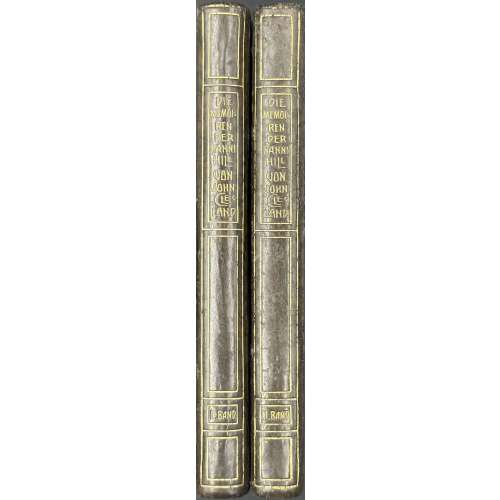 Two hardcover volumes, 17 x 11.5 cm, collated in-8vo, uniformly bound in dark grey mottled calf bordered with gilt fillet, flat spine with gilt lettering in compartments outlined in gilt; top edge gilt, text and plates printed on dense wove paper (Japanpapier). Privately printed by Gustav Röttig & Sohn (Ödenburg) in 800 copies, of which this is copy № 16, signed by von Bayros in 1st vol. Each volume is illustrated with four heliogravures (title-page and three plates) after drawings by Franz von Bayros. According to the seller, this is one of only 35 copies of the deluxe edition on Japanpapier, a fact which was mentioned by the bibliographers but not in the imprint. Bookplate to front pastedown in each volume, lettering to bottom “Ex libris Dr. phil. Rudolf Ludwig”, 120 x 100 mm, heliogravure after von Bayros. Pp.: vol. 1 [4] 1-198 plus engraved t.p. and 3 plates. Vol. 2: 1-204 [2] plus engraved t.p. and 3 plates. Title-page: DIE MEMOIREN | DER | FANNY HILL | VON | JOHN CLELAND | ESTER (ZWEITER) BAND | PAPHOS IM JAHR DER | CYTHERE | MDCCCCVI || Author of the text: John Cleland (British, c. 1709 – 1789). Translator: Franz Blei [Dr. Erich Feldhammer] (Austrian, 1871 – 1942). Illustrator: Franz von Bayros (Austrian, 1866 – 1924). Provenance: Dr. Phil. Rudolf Ludwig. Catalogue raisonné: The amorous drawings of the Marquis von Bayros. — New York: Cythera Press, 1968. The Beautiful Maiden of Pao, pp. 31-38. Seller's Description: Erster [und] Zweiter Band. Paphos [Wien, C. W. Stern], im Jahr der Cythere 1906. Mit sechs Tafeln und zwei illustrierten Titeln nach Franz von Bayros, alle zweifarbig. Grau marmorierte Originalkalblederbände mit Rücken-, Deckelkanten- und Kopfschnittvergoldung. Privatdruck. – Eins von 35 Exemplaren der Luxusausgabe auf Japanpapier, im Druckvermerk von Band I von Bayros signiert. – Die Übersetzung stammt von Franz Blei, der hier unter dem Pseudonym Dr. Erich Feldhammer genannt wird. Als Textvorlage diente die Ausgabe London 1749. – Gedruckt wurde bei Gustav Röttig & Sohn in Ödenburg. – Sehr seltene Vorzugsausgabe, die zwar bei den Bibliographen, nicht aber im Druckvermerk genannt wurde. – Fast tadellos. – »Dieses Werk ist eines der berühmtesten in der erotischen Literatur« (Stern-Szana). Nach Hinweis bei Brettschneider wurde die Auflage beschlagnahmt. – Exlibris Dr. phil. Rudolf Ludwig, Wien (Heliogravüre nach Zeichnung von Franz von Bayros, Brettschneider 156) in beiden Bänden. 17 : 11,5 cm. [4], 198, [2], [4], 204, [2] Seiten. Zusammen 8 Tafeln. Brettschneider 38. – Hayn/Gotendorf I, 618. – Stern-Szana 243 und ausführlich S. 222ff
Two hardcover volumes, 17 x 11.5 cm, collated in-8vo, uniformly bound in dark grey mottled calf bordered with gilt fillet, flat spine with gilt lettering in compartments outlined in gilt; top edge gilt, text and plates printed on dense wove paper (Japanpapier). Privately printed by Gustav Röttig & Sohn (Ödenburg) in 800 copies, of which this is copy № 16, signed by von Bayros in 1st vol. Each volume is illustrated with four heliogravures (title-page and three plates) after drawings by Franz von Bayros. According to the seller, this is one of only 35 copies of the deluxe edition on Japanpapier, a fact which was mentioned by the bibliographers but not in the imprint. Bookplate to front pastedown in each volume, lettering to bottom “Ex libris Dr. phil. Rudolf Ludwig”, 120 x 100 mm, heliogravure after von Bayros. Pp.: vol. 1 [4] 1-198 plus engraved t.p. and 3 plates. Vol. 2: 1-204 [2] plus engraved t.p. and 3 plates. Title-page: DIE MEMOIREN | DER | FANNY HILL | VON | JOHN CLELAND | ESTER (ZWEITER) BAND | PAPHOS IM JAHR DER | CYTHERE | MDCCCCVI || Author of the text: John Cleland (British, c. 1709 – 1789). Translator: Franz Blei [Dr. Erich Feldhammer] (Austrian, 1871 – 1942). Illustrator: Franz von Bayros (Austrian, 1866 – 1924). Provenance: Dr. Phil. Rudolf Ludwig. Catalogue raisonné: The amorous drawings of the Marquis von Bayros. — New York: Cythera Press, 1968. The Beautiful Maiden of Pao, pp. 31-38. Seller's Description: Erster [und] Zweiter Band. Paphos [Wien, C. W. Stern], im Jahr der Cythere 1906. Mit sechs Tafeln und zwei illustrierten Titeln nach Franz von Bayros, alle zweifarbig. Grau marmorierte Originalkalblederbände mit Rücken-, Deckelkanten- und Kopfschnittvergoldung. Privatdruck. – Eins von 35 Exemplaren der Luxusausgabe auf Japanpapier, im Druckvermerk von Band I von Bayros signiert. – Die Übersetzung stammt von Franz Blei, der hier unter dem Pseudonym Dr. Erich Feldhammer genannt wird. Als Textvorlage diente die Ausgabe London 1749. – Gedruckt wurde bei Gustav Röttig & Sohn in Ödenburg. – Sehr seltene Vorzugsausgabe, die zwar bei den Bibliographen, nicht aber im Druckvermerk genannt wurde. – Fast tadellos. – »Dieses Werk ist eines der berühmtesten in der erotischen Literatur« (Stern-Szana). Nach Hinweis bei Brettschneider wurde die Auflage beschlagnahmt. – Exlibris Dr. phil. Rudolf Ludwig, Wien (Heliogravüre nach Zeichnung von Franz von Bayros, Brettschneider 156) in beiden Bänden. 17 : 11,5 cm. [4], 198, [2], [4], 204, [2] Seiten. Zusammen 8 Tafeln. Brettschneider 38. – Hayn/Gotendorf I, 618. – Stern-Szana 243 und ausführlich S. 222ff -
 Colour (tone) lithography, image 396 x 508 mm, sheet 532 x 654 mm; before signature, undated; pencil ms inscription: Föhrenhain — E. Pelikan / 200M to the lower-right corner of the sheet. Contributor: Emilie Mediz-Pelikan (Austrian, 1861 – 1908) – artist. Seller's description: Austrian-German painter and graphic artist. Emilie Mediz-Pelikan was born in Vöcklabruck in 1861. She studied at the Vienna Academy and followed her teacher Albert Zimmermann to Salzburg and in 1885 to Munich. In 1891 she married the painter and graphic artist Karl Mediz (1868 - 1945), with whom she lived in Vienna and from 1894 in Dresden. She was in contact with the Dachau Artists' Colony and went on study trips to Paris, Belgium, Hungary and Italy. In the Dachau artists' colony she was friends with Adolf Hölzel and Fritz von Uhde. In 1889 and 1890 she spent time in Paris and in the Belgian artists' colony Knokke. In 1898 she was represented at the first art exhibition of the Vienna Secession, and in 1901 at the International Art Exhibition in Dresden. In 1903 she and her husband had a group exhibition, at the Hagenbund in Vienna. In 1904, she showed graphic works at the Dresden royal court art dealer Richter, and in 1905 and 1906 she exhibited at the Berlin Künstlerhaus. It was not until around 1900 that she achieved her artistic breakthrough with her landscape paintings. Since the estate of the artist, who died prematurely in Dresden in 1908, was lost in the former GDR until the 1980s, it was quite late that the artist was rediscovered and revalued both in Austrian art history and on the art market. In 1986, the first major exhibitions took place at the Upper Austrian State Museum and the University of Applied Arts in Vienna, followed by numerous smaller exhibitions in private galleries in Vienna, Linz and Munich. The artist received recognition during her lifetime from numerous prominent fellow painters as well as from the art critic Ludwig Hevesi. Together with Tina Blau, Herbert Boeckl, Marie Egner, Theodor von Hörmann, Franz Jaschke, Eugen Jettel, Ludwig Heinrich Jungnickel, Rudolf Junk, Gustav Klimt, Oskar Kokoschka, Johann Victor Krämer, Heinrich Kühn, Carl Moll, Rudolf Quittner, Rudolf Ribarz, Emil Jakob Schindler, Max Suppantschitsch, Max Weiler, Olga Wisinger-Florian and Alfred Zoff, she was a protagonist of the reception of Impressionism in Austria. This style went down in Austrian art history under the term "Stimmungsimpressionismus".
Colour (tone) lithography, image 396 x 508 mm, sheet 532 x 654 mm; before signature, undated; pencil ms inscription: Föhrenhain — E. Pelikan / 200M to the lower-right corner of the sheet. Contributor: Emilie Mediz-Pelikan (Austrian, 1861 – 1908) – artist. Seller's description: Austrian-German painter and graphic artist. Emilie Mediz-Pelikan was born in Vöcklabruck in 1861. She studied at the Vienna Academy and followed her teacher Albert Zimmermann to Salzburg and in 1885 to Munich. In 1891 she married the painter and graphic artist Karl Mediz (1868 - 1945), with whom she lived in Vienna and from 1894 in Dresden. She was in contact with the Dachau Artists' Colony and went on study trips to Paris, Belgium, Hungary and Italy. In the Dachau artists' colony she was friends with Adolf Hölzel and Fritz von Uhde. In 1889 and 1890 she spent time in Paris and in the Belgian artists' colony Knokke. In 1898 she was represented at the first art exhibition of the Vienna Secession, and in 1901 at the International Art Exhibition in Dresden. In 1903 she and her husband had a group exhibition, at the Hagenbund in Vienna. In 1904, she showed graphic works at the Dresden royal court art dealer Richter, and in 1905 and 1906 she exhibited at the Berlin Künstlerhaus. It was not until around 1900 that she achieved her artistic breakthrough with her landscape paintings. Since the estate of the artist, who died prematurely in Dresden in 1908, was lost in the former GDR until the 1980s, it was quite late that the artist was rediscovered and revalued both in Austrian art history and on the art market. In 1986, the first major exhibitions took place at the Upper Austrian State Museum and the University of Applied Arts in Vienna, followed by numerous smaller exhibitions in private galleries in Vienna, Linz and Munich. The artist received recognition during her lifetime from numerous prominent fellow painters as well as from the art critic Ludwig Hevesi. Together with Tina Blau, Herbert Boeckl, Marie Egner, Theodor von Hörmann, Franz Jaschke, Eugen Jettel, Ludwig Heinrich Jungnickel, Rudolf Junk, Gustav Klimt, Oskar Kokoschka, Johann Victor Krämer, Heinrich Kühn, Carl Moll, Rudolf Quittner, Rudolf Ribarz, Emil Jakob Schindler, Max Suppantschitsch, Max Weiler, Olga Wisinger-Florian and Alfred Zoff, she was a protagonist of the reception of Impressionism in Austria. This style went down in Austrian art history under the term "Stimmungsimpressionismus". -
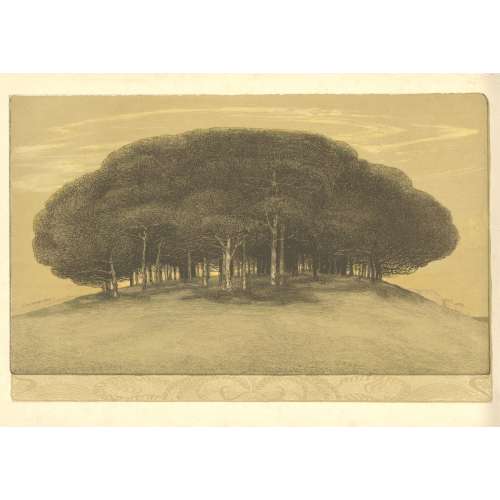 Colour (tone) lithography, image 268 x 410 mm, sheet 317 x 470 mm; signed on bottom-left of the image “Pelikan 1905”, and pencil ms inscription: E. Pelikan to the lower-right corner of the sheet. Contributor: Emilie Mediz-Pelikan (Austrian, 1861 – 1908) – artist. Seller's description: Austrian-German painter and graphic artist. Emilie Mediz-Pelikan was born in Vöcklabruck in 1861. She studied at the Vienna Academy and followed her teacher Albert Zimmermann to Salzburg and in 1885 to Munich. In 1891 she married the painter and graphic artist Karl Mediz (1868 - 1945), with whom she lived in Vienna and from 1894 in Dresden. She was in contact with the Dachau Artists' Colony and went on study trips to Paris, Belgium, Hungary and Italy. In the Dachau artists' colony she was friends with Adolf Hölzel and Fritz von Uhde. In 1889 and 1890 she spent time in Paris and in the Belgian artists' colony Knokke. In 1898 she was represented at the first art exhibition of the Vienna Secession, and in 1901 at the International Art Exhibition in Dresden. In 1903 she and her husband had a group exhibition, at the Hagenbund in Vienna. In 1904, she showed graphic works at the Dresden royal court art dealer Richter, and in 1905 and 1906 she exhibited at the Berlin Künstlerhaus. It was not until around 1900 that she achieved her artistic breakthrough with her landscape paintings. Since the estate of the artist, who died prematurely in Dresden in 1908, was lost in the former GDR until the 1980s, it was quite late that the artist was rediscovered and revalued both in Austrian art history and on the art market. In 1986, the first major exhibitions took place at the Upper Austrian State Museum and the University of Applied Arts in Vienna, followed by numerous smaller exhibitions in private galleries in Vienna, Linz and Munich. The artist received recognition during her lifetime from numerous prominent fellow painters as well as from the art critic Ludwig Hevesi. Together with Tina Blau, Herbert Boeckl, Marie Egner, Theodor von Hörmann, Franz Jaschke, Eugen Jettel, Ludwig Heinrich Jungnickel, Rudolf Junk, Gustav Klimt, Oskar Kokoschka, Johann Victor Krämer, Heinrich Kühn, Carl Moll, Rudolf Quittner, Rudolf Ribarz, Emil Jakob Schindler, Max Suppantschitsch, Max Weiler, Olga Wisinger-Florian and Alfred Zoff, she was a protagonist of the reception of Impressionism in Austria. This style went down in Austrian art history under the term "Stimmungsimpressionismus".
Colour (tone) lithography, image 268 x 410 mm, sheet 317 x 470 mm; signed on bottom-left of the image “Pelikan 1905”, and pencil ms inscription: E. Pelikan to the lower-right corner of the sheet. Contributor: Emilie Mediz-Pelikan (Austrian, 1861 – 1908) – artist. Seller's description: Austrian-German painter and graphic artist. Emilie Mediz-Pelikan was born in Vöcklabruck in 1861. She studied at the Vienna Academy and followed her teacher Albert Zimmermann to Salzburg and in 1885 to Munich. In 1891 she married the painter and graphic artist Karl Mediz (1868 - 1945), with whom she lived in Vienna and from 1894 in Dresden. She was in contact with the Dachau Artists' Colony and went on study trips to Paris, Belgium, Hungary and Italy. In the Dachau artists' colony she was friends with Adolf Hölzel and Fritz von Uhde. In 1889 and 1890 she spent time in Paris and in the Belgian artists' colony Knokke. In 1898 she was represented at the first art exhibition of the Vienna Secession, and in 1901 at the International Art Exhibition in Dresden. In 1903 she and her husband had a group exhibition, at the Hagenbund in Vienna. In 1904, she showed graphic works at the Dresden royal court art dealer Richter, and in 1905 and 1906 she exhibited at the Berlin Künstlerhaus. It was not until around 1900 that she achieved her artistic breakthrough with her landscape paintings. Since the estate of the artist, who died prematurely in Dresden in 1908, was lost in the former GDR until the 1980s, it was quite late that the artist was rediscovered and revalued both in Austrian art history and on the art market. In 1986, the first major exhibitions took place at the Upper Austrian State Museum and the University of Applied Arts in Vienna, followed by numerous smaller exhibitions in private galleries in Vienna, Linz and Munich. The artist received recognition during her lifetime from numerous prominent fellow painters as well as from the art critic Ludwig Hevesi. Together with Tina Blau, Herbert Boeckl, Marie Egner, Theodor von Hörmann, Franz Jaschke, Eugen Jettel, Ludwig Heinrich Jungnickel, Rudolf Junk, Gustav Klimt, Oskar Kokoschka, Johann Victor Krämer, Heinrich Kühn, Carl Moll, Rudolf Quittner, Rudolf Ribarz, Emil Jakob Schindler, Max Suppantschitsch, Max Weiler, Olga Wisinger-Florian and Alfred Zoff, she was a protagonist of the reception of Impressionism in Austria. This style went down in Austrian art history under the term "Stimmungsimpressionismus". -
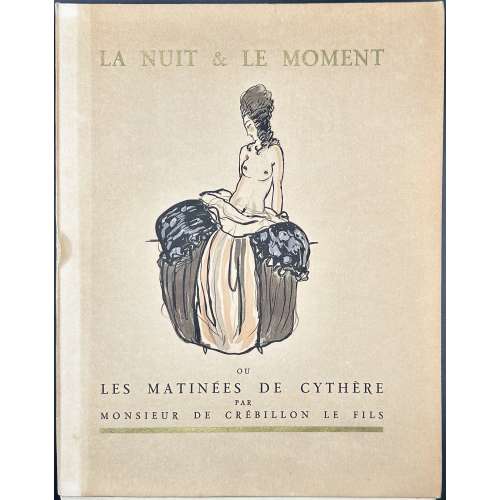 Softcover volume, 33 x 26 cm, collated in folio, not bound, in publisher’s French flapped pictorial wrappers, lettering to spine; printed on thick wove Arches paper watermarked “MBM”, upper edge trimmed, owner’s blind stamp to h.t. “Ex Libris Comte Tony de Vibraye”, glassine dust jacket, in a slipcase. Collation: π2 1-262, total 54 leaves, plus 4 leaves in wrappers, plus 10 plates, incl. frontispiece; coloured aquatints after Sylvain Sauvage; coloured etched vignette to front wrapper, gilt woodcut to back wrapper, woodcut title-page and woodcut headpiece after the same. Pp.: [4] [1] 2-102 [2]. Front wrapper (gilt and black): LA NUIT & LE MOMENT | {vignette} | OU | LES MATINÉES DE CYTHÈRE | PAR | MONSIEUR DE CRÉBILLON LE FILS | — || Title-page (woodcut): CRÉBILLON LE FILS | — | LA NUIT ET LE MOMENT | OU | LES MATINÉES | DE CYTHÈRE | {vignette} | A PARIS | AUX DEPENS D'UN AMATEUR | — | M CM XXIV || Limitation: De cette édition il a été tiré un exemplaire unique sur japon impérial comportant dix aquarelles originales, deux cents trente exemplaires sur vélin d' Arches numérotés 1 à 230, dont les dix premiers avec une suite de hors texte sur japon. N° 1 [Print run limited to 230 copies on Arches plus a unique copy on Japon with original watercolours, this is copy № 1 on wove paper]. Seller’s description: La Nuit et le moment ou Les Matinées de Cythère. Paris, Au dépens d'un amateur, 1924. In-4, en feuilles, non rogné, couverture illustrée et étui. Ouvrage illustré de 4 gravures sur bois et de 10 eaux-fortes libres en couleurs hors texte de Sylvain Sauvage. Tirage à 231 exemplaires, celui-ci le n°1 sur vélin d'Arches. Manque la suite de hors texte sur japon. De la bibliothèque du Comte Tony de Vibraye, avec cachet à froid. Dutel, n°2062. Catalogue raisonné: honesterotica.com; Dutel III 2062. Contributors: Claude-Prosper Jolyot de Crébillon [Crébillon fils] (French, 1707 – 1777) – author. Sylvain Sauvage [Félix Roy] (French, 1888 – 1948) – artist. Provenance: Antoine Henri Gaston Hurault de Vibraye [Comte Tony de Vibraye] (French, 1893 – 1951)
Softcover volume, 33 x 26 cm, collated in folio, not bound, in publisher’s French flapped pictorial wrappers, lettering to spine; printed on thick wove Arches paper watermarked “MBM”, upper edge trimmed, owner’s blind stamp to h.t. “Ex Libris Comte Tony de Vibraye”, glassine dust jacket, in a slipcase. Collation: π2 1-262, total 54 leaves, plus 4 leaves in wrappers, plus 10 plates, incl. frontispiece; coloured aquatints after Sylvain Sauvage; coloured etched vignette to front wrapper, gilt woodcut to back wrapper, woodcut title-page and woodcut headpiece after the same. Pp.: [4] [1] 2-102 [2]. Front wrapper (gilt and black): LA NUIT & LE MOMENT | {vignette} | OU | LES MATINÉES DE CYTHÈRE | PAR | MONSIEUR DE CRÉBILLON LE FILS | — || Title-page (woodcut): CRÉBILLON LE FILS | — | LA NUIT ET LE MOMENT | OU | LES MATINÉES | DE CYTHÈRE | {vignette} | A PARIS | AUX DEPENS D'UN AMATEUR | — | M CM XXIV || Limitation: De cette édition il a été tiré un exemplaire unique sur japon impérial comportant dix aquarelles originales, deux cents trente exemplaires sur vélin d' Arches numérotés 1 à 230, dont les dix premiers avec une suite de hors texte sur japon. N° 1 [Print run limited to 230 copies on Arches plus a unique copy on Japon with original watercolours, this is copy № 1 on wove paper]. Seller’s description: La Nuit et le moment ou Les Matinées de Cythère. Paris, Au dépens d'un amateur, 1924. In-4, en feuilles, non rogné, couverture illustrée et étui. Ouvrage illustré de 4 gravures sur bois et de 10 eaux-fortes libres en couleurs hors texte de Sylvain Sauvage. Tirage à 231 exemplaires, celui-ci le n°1 sur vélin d'Arches. Manque la suite de hors texte sur japon. De la bibliothèque du Comte Tony de Vibraye, avec cachet à froid. Dutel, n°2062. Catalogue raisonné: honesterotica.com; Dutel III 2062. Contributors: Claude-Prosper Jolyot de Crébillon [Crébillon fils] (French, 1707 – 1777) – author. Sylvain Sauvage [Félix Roy] (French, 1888 – 1948) – artist. Provenance: Antoine Henri Gaston Hurault de Vibraye [Comte Tony de Vibraye] (French, 1893 – 1951) -
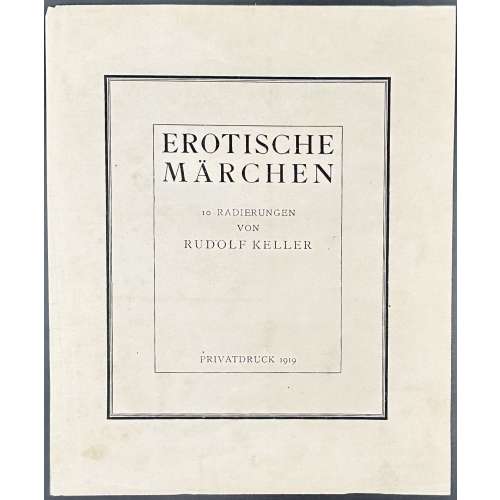 Portfolio 265 x 225 mm, black half-buckram over diapered cardboard with flaps, black with gilt lettering in frame to front “R. KELLER | MÄRCHEN”, t.p. printed on wave paper, the folder and engravings printed on laid paper, 10 loose plates, 240 x 210 mm sheet, 135 x 110-115 mm plate; re-issue of ten plates of the first edition of 16 plates published in Austria in c. 1910s. Title-page: EROTISCHE | MÄRCHEN | 10 RADIERUNGEN | VON | RUDOLF KELLER | PRIVATDRUCK 1919 || Die Mappe enthält folgende originalradierungen: 1. Aschenbrödel; 2. Dornröschen; 3. Zwerg Nase; 4. Froschkönig; 5. Der gestiefelte Kater; 6. Hänsel und Gretel; 7. Der fliegende Koffer; 8. Schneewittchen mit den 7 Zwergen; 9. Die kleine Seejungfer; 10. Der kleine Daumling Dieses Werk wurde in einer einmaligen Auflage von 250 numerierten Exemplaren hergestellt und darf nur an Gelehrte und Sammler abgegeben werden. Die Platten wurden vernichtet. Nr. 1—50 sind vom Künstler signierte Vorzugsdrucke. Dieses Exemplar erhielt Nr. 0153. Translation: The folder contains the following original etchings: 1. Cinderella; 2. Sleeping Beauty; 3. Dwarf nose; 4. The Frog Prince; 5. Puss in Boots; 6. Hansel and Gretel; 7. The Flying Trunk; 8. Snow White with the Seven Dwarfs; 9. The Little Mermaid; 10. Little Thumbling. This work was produced in a one-time edition of 250 numbered copies and may only be sold to scholars and collectors. The copperplates were destroyed. Nos. 1-50 are special prints signed by the artist. This copy was given number 0153. Seller's description: Erotische Märchen. S.l., Privatdruck, 1919. In-8, en feuilles, sous chemise demi-chagrin vert recouverte de papier japonais. Recueil de 10 eaux-fortes originales de Rudolf Keller. Ces eaux-fortes érotiques dans les teintes brunes s'inspirent des contes de fées traditionnels comme Cendrillon, La Belle au bois dormant, Hansel et Gretel, Blanche-Neige, Le Petit Poucet etc. Tirage à 250 exemplaires. Chemise défraîchie. Jacob Grimm (German; 1785 – 1863) Wilhelm Grimm (German, 1786 – 1859) Charles Perrault (French, 1628 – 1703) Hans Christian Andersen (Danish, 1805 – 1875)
Portfolio 265 x 225 mm, black half-buckram over diapered cardboard with flaps, black with gilt lettering in frame to front “R. KELLER | MÄRCHEN”, t.p. printed on wave paper, the folder and engravings printed on laid paper, 10 loose plates, 240 x 210 mm sheet, 135 x 110-115 mm plate; re-issue of ten plates of the first edition of 16 plates published in Austria in c. 1910s. Title-page: EROTISCHE | MÄRCHEN | 10 RADIERUNGEN | VON | RUDOLF KELLER | PRIVATDRUCK 1919 || Die Mappe enthält folgende originalradierungen: 1. Aschenbrödel; 2. Dornröschen; 3. Zwerg Nase; 4. Froschkönig; 5. Der gestiefelte Kater; 6. Hänsel und Gretel; 7. Der fliegende Koffer; 8. Schneewittchen mit den 7 Zwergen; 9. Die kleine Seejungfer; 10. Der kleine Daumling Dieses Werk wurde in einer einmaligen Auflage von 250 numerierten Exemplaren hergestellt und darf nur an Gelehrte und Sammler abgegeben werden. Die Platten wurden vernichtet. Nr. 1—50 sind vom Künstler signierte Vorzugsdrucke. Dieses Exemplar erhielt Nr. 0153. Translation: The folder contains the following original etchings: 1. Cinderella; 2. Sleeping Beauty; 3. Dwarf nose; 4. The Frog Prince; 5. Puss in Boots; 6. Hansel and Gretel; 7. The Flying Trunk; 8. Snow White with the Seven Dwarfs; 9. The Little Mermaid; 10. Little Thumbling. This work was produced in a one-time edition of 250 numbered copies and may only be sold to scholars and collectors. The copperplates were destroyed. Nos. 1-50 are special prints signed by the artist. This copy was given number 0153. Seller's description: Erotische Märchen. S.l., Privatdruck, 1919. In-8, en feuilles, sous chemise demi-chagrin vert recouverte de papier japonais. Recueil de 10 eaux-fortes originales de Rudolf Keller. Ces eaux-fortes érotiques dans les teintes brunes s'inspirent des contes de fées traditionnels comme Cendrillon, La Belle au bois dormant, Hansel et Gretel, Blanche-Neige, Le Petit Poucet etc. Tirage à 250 exemplaires. Chemise défraîchie. Jacob Grimm (German; 1785 – 1863) Wilhelm Grimm (German, 1786 – 1859) Charles Perrault (French, 1628 – 1703) Hans Christian Andersen (Danish, 1805 – 1875) -
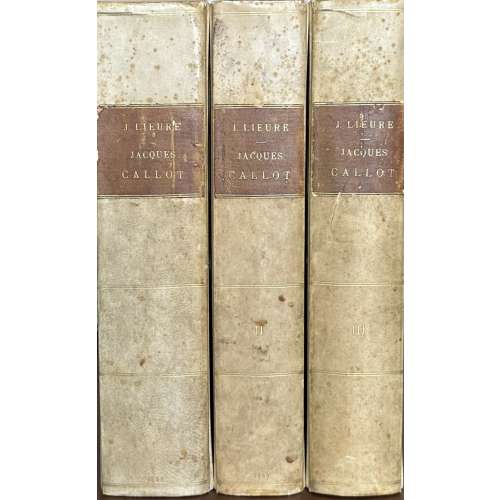 Three volumes, 33 x 26.5 x 7 cm each, uniformly bound in 2/3 vellum over marbled boards, outlined with gilt fillet, brown label with gilt lettering to flat spine with double fillet faux-bands, marbled endpapers, top edge gilt, other untrimmed, publisher’s wrappers preserved, incl. spine; collotype plates with captioned glassine guards; armorial bookplate of Comte Alain de Suzannet to front pastedown in each volume. Two volumes of Première partie, wanting, contain La vie artistique : texte and La vie artistique : planches. Title-page (red and black): JACQUES CALLOT | PAR | J. LIEURE | Introduction de F. Courboin | Conservateur du Cabinet des Estampes à la Bibliothèque Nationale | — | DEUXIÈME PARTIE | CATALOGUE DE L’ŒUVRE GRAVÉ | TOME I (II, III) | — | PARIS | ÉDITIONS DE LA GAZETTE DES BEAUX-ARTS | 106, Boulevard Saint-Germain (6e) | 1924 (1927, 1927) || Vol. 1 (1924): [4] [1] 2-122 [2], wrappers, plates 1-299; printed on September 15, 1924, by André Lesot (Nemours) and D. Jacomet et Cie (Paris). Vol. 2 (1927): [4] [1] 2-106 [2], wrappers, plates 300-652. Vol. 3 (1927): [4] [1] 2-128 [4], wrappers, plates 653-1428; printed on September 5, 1926, by Imprimerie moderne des Beaux-Arts (Bois-Colombes) and D. Jacomet et Cie (Paris). Contributors: Jules Lieure (French, 1866 – 1948) – author. Jacques Callot (French, c. 1592 – 1635) – artist. Gazette des Beaux-Arts (f. 1859) – publisher. François Courboin (French, 1865 – 1926) – author. D. Jacomet et Cie (Paris) – printer. Daniel Jacomet (French, 1894 – 1966) – printer. André Lesot (French, 1874-1951) – printer. Imprimerie moderne des Beaux-Arts (Bois-Colombes) Comte Alain de Suzannet (French, 1882 – 1950) – provenance.
Three volumes, 33 x 26.5 x 7 cm each, uniformly bound in 2/3 vellum over marbled boards, outlined with gilt fillet, brown label with gilt lettering to flat spine with double fillet faux-bands, marbled endpapers, top edge gilt, other untrimmed, publisher’s wrappers preserved, incl. spine; collotype plates with captioned glassine guards; armorial bookplate of Comte Alain de Suzannet to front pastedown in each volume. Two volumes of Première partie, wanting, contain La vie artistique : texte and La vie artistique : planches. Title-page (red and black): JACQUES CALLOT | PAR | J. LIEURE | Introduction de F. Courboin | Conservateur du Cabinet des Estampes à la Bibliothèque Nationale | — | DEUXIÈME PARTIE | CATALOGUE DE L’ŒUVRE GRAVÉ | TOME I (II, III) | — | PARIS | ÉDITIONS DE LA GAZETTE DES BEAUX-ARTS | 106, Boulevard Saint-Germain (6e) | 1924 (1927, 1927) || Vol. 1 (1924): [4] [1] 2-122 [2], wrappers, plates 1-299; printed on September 15, 1924, by André Lesot (Nemours) and D. Jacomet et Cie (Paris). Vol. 2 (1927): [4] [1] 2-106 [2], wrappers, plates 300-652. Vol. 3 (1927): [4] [1] 2-128 [4], wrappers, plates 653-1428; printed on September 5, 1926, by Imprimerie moderne des Beaux-Arts (Bois-Colombes) and D. Jacomet et Cie (Paris). Contributors: Jules Lieure (French, 1866 – 1948) – author. Jacques Callot (French, c. 1592 – 1635) – artist. Gazette des Beaux-Arts (f. 1859) – publisher. François Courboin (French, 1865 – 1926) – author. D. Jacomet et Cie (Paris) – printer. Daniel Jacomet (French, 1894 – 1966) – printer. André Lesot (French, 1874-1951) – printer. Imprimerie moderne des Beaux-Arts (Bois-Colombes) Comte Alain de Suzannet (French, 1882 – 1950) – provenance. -
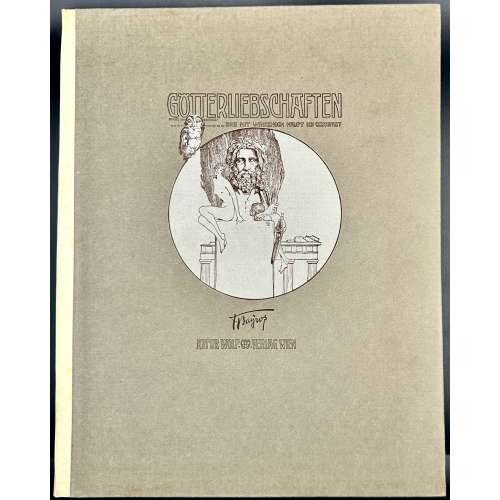 Letterpress title-page, engraved title-page, and 10 sheets of collotype plates printed on india paper mounted on thick wove paper, with captioned guard sheets, loose in a vellum-backed cardboard portfolio with cloth-mounted flaps; floral diaper design inside throughout; bookseller's label to front board verso; limited edition of 550 copies of which this is copy № 103. Dimensions: 338 x 268 mm portfolio; 325 x 260 mm sheet, 225 x 195 mm image. Front board with lettering and vignette: GÖTTERLIEBSCHAFTEN | DAS MIT WINKENDEM HAUPT ICH GEWAHRET | {vignette} | {signature} | ARTUR WOLF / VERLAG WIEN || Letterpress title-page: FRANZ VON BAYROS | “GÖTTERLIEBSCHAFTEN” | ARTUR WOLF / VERLAG WIEN | 1914 || Verso to letterpress t.p. VERZEICHNIS DER TAFELN.
Letterpress title-page, engraved title-page, and 10 sheets of collotype plates printed on india paper mounted on thick wove paper, with captioned guard sheets, loose in a vellum-backed cardboard portfolio with cloth-mounted flaps; floral diaper design inside throughout; bookseller's label to front board verso; limited edition of 550 copies of which this is copy № 103. Dimensions: 338 x 268 mm portfolio; 325 x 260 mm sheet, 225 x 195 mm image. Front board with lettering and vignette: GÖTTERLIEBSCHAFTEN | DAS MIT WINKENDEM HAUPT ICH GEWAHRET | {vignette} | {signature} | ARTUR WOLF / VERLAG WIEN || Letterpress title-page: FRANZ VON BAYROS | “GÖTTERLIEBSCHAFTEN” | ARTUR WOLF / VERLAG WIEN | 1914 || Verso to letterpress t.p. VERZEICHNIS DER TAFELN.- Europa und der Stier
- Leda und die Schildkröte
- Sterope und Herkules
- Herodikos und die Turnerinnen
- Phoroneus und die Hirtin
- Minos und Persipeia
- Phryne und Mutter
- Pytalos und Demeter
- Kirke und die Ferkel
- Putiphar
-
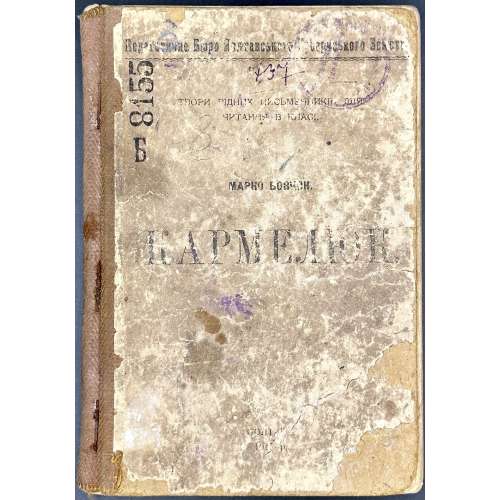 Owner’s quarter brown cloth, 18.2 x 12.5 cm, lettered paper over cardboard; text printed on tan paper, [1, 2] (t.p.), [i] ii-viii (intro.), [1] 4-48 (text); total 28 leaves; blue and red crayon marks to text; boards and pages with blue ink stamps and inscriptions. Front board: Педагогичне Бюро Полтавського Губернського Земства. | ТВОРИ РІДНИХ ПИСЬМЕННИКІВ ДЛЯ | ЧИТАННЯ В КЛАСІ.| МАРКО ВОВЧОК. | КАРМЕЛЮК. | ПОЛТАВА. | 1917 р. || Back board: Серія складається з творів: | Квітки, Вовчка, Шевченка, Куліша, | Руданського, Левицького І, Мирного, | Франка, Грінченка, Коцюбинського. | Полтава, друкарня Амчиславського. || Title-page: Педагогичне Бюро Полтавського Губернського Земства. | МАРКО ВОВЧОК. | КАРМЕЛЮК. | ПОЛТАВА. | 1917 р. || Contributors: Марко Вовчок [Marko Vovchok; Марія Олександрівна Вілінська] (Ukrainian, 1833 – 1907) – author. Other variants: Markowovzok and Marko Vovtchok. Амчиславский, М. Г. (Полтава, ул. Пушкина, 40) – printer.
Owner’s quarter brown cloth, 18.2 x 12.5 cm, lettered paper over cardboard; text printed on tan paper, [1, 2] (t.p.), [i] ii-viii (intro.), [1] 4-48 (text); total 28 leaves; blue and red crayon marks to text; boards and pages with blue ink stamps and inscriptions. Front board: Педагогичне Бюро Полтавського Губернського Земства. | ТВОРИ РІДНИХ ПИСЬМЕННИКІВ ДЛЯ | ЧИТАННЯ В КЛАСІ.| МАРКО ВОВЧОК. | КАРМЕЛЮК. | ПОЛТАВА. | 1917 р. || Back board: Серія складається з творів: | Квітки, Вовчка, Шевченка, Куліша, | Руданського, Левицького І, Мирного, | Франка, Грінченка, Коцюбинського. | Полтава, друкарня Амчиславського. || Title-page: Педагогичне Бюро Полтавського Губернського Земства. | МАРКО ВОВЧОК. | КАРМЕЛЮК. | ПОЛТАВА. | 1917 р. || Contributors: Марко Вовчок [Marko Vovchok; Марія Олександрівна Вілінська] (Ukrainian, 1833 – 1907) – author. Other variants: Markowovzok and Marko Vovtchok. Амчиславский, М. Г. (Полтава, ул. Пушкина, 40) – printer. -
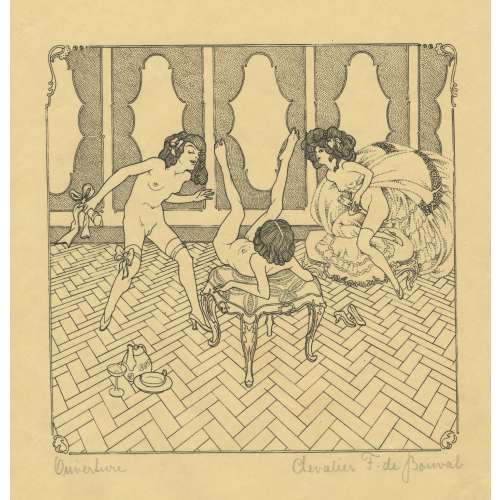 A set of sixteen planographic prints, signed and titled in pencil by owner “Chevalier F. de Bouval” (pseudonym of Franz von Bayros (Austrian, 1866 – 1924). Titles include: 1) Ouverture, 2) champagne brut, 3) maternité, 4) piano, 5) crudité délicieuse, 6. la belle vue, 7) au pensionnat, 8) le collier, 9) languelles pénètrelles, 10) introduction, 11) le sourrogat, 12) variation amoureuse, 13) la surprise, 14) le clef délicat, 15) le monstre gomme, 16) fruits de sud. Printed on wove paper, possibly engraved on wood after ink drawings by Franz von Bayros (Austrian, 1866 – 1924) under the pseudonym Chevalier F. de Bouval. Size: sheet 30 x 24 cm, image 18 x 17.5 cm. In another source, there are two more images from the same set: le passe-partout and la doublette, making 18 images altogether; the set is titled “Lesbia: XVIII sujets”, signed by Chevalier François René de Bouval.
A set of sixteen planographic prints, signed and titled in pencil by owner “Chevalier F. de Bouval” (pseudonym of Franz von Bayros (Austrian, 1866 – 1924). Titles include: 1) Ouverture, 2) champagne brut, 3) maternité, 4) piano, 5) crudité délicieuse, 6. la belle vue, 7) au pensionnat, 8) le collier, 9) languelles pénètrelles, 10) introduction, 11) le sourrogat, 12) variation amoureuse, 13) la surprise, 14) le clef délicat, 15) le monstre gomme, 16) fruits de sud. Printed on wove paper, possibly engraved on wood after ink drawings by Franz von Bayros (Austrian, 1866 – 1924) under the pseudonym Chevalier F. de Bouval. Size: sheet 30 x 24 cm, image 18 x 17.5 cm. In another source, there are two more images from the same set: le passe-partout and la doublette, making 18 images altogether; the set is titled “Lesbia: XVIII sujets”, signed by Chevalier François René de Bouval.


